Damage Identification in Cement-Based Structures: A Method Based on Modal Curvatures and Continuous Wavelet Transform
Abstract
:1. Introduction
- Evaluating the changes in terms of modal parameters of scaled concrete beams subjected to loading tests leading to cracking phenomena.
- Analyzing the modal curvatures also through continuous wavelet transform.
- Proposing damage indices considering both the curvature change and the CWT-based analysis.
- Evaluating the sensitivity of the results with respect to data processing parameters.
2. Materials and Methods
- -
- Mixing of sand and intermediate/coarse gravels (2 min).
- -
- Addition of cement and further mixing (2 min).
- -
- Addition of BCH and further mixing (7 min).
- -
- Addition of RCF and further mixing (2 min).
- -
- Water addition and further mixing (10 min).
- -
- Pouring of fresh mix in moulds.
- -
- n. 6 sensorized specimens: sensors for the measurement of electrical impedance and free corrosion potential were embedded in the specimens for SHM purposes (both beyond the scope of this article, but very important to continuously monitor the health status of the material). Plastic tubes were employed for easing the cable routing; they require particular attention since they inevitably contribute to the determination of the element dynamic behaviour. The layout of the specimens is reported in Figure 1.
- -
- n. 6 non-sensorized specimens: these were manufactured to evaluate the effect of the embedded sensors on the dynamic behaviour of the elements (rigidity should be affected by sensors, representing discontinuities in the material) and the consequent modal parameters. Half of them were dedicated to the assessment of flexural strength according to the EN 12390-5 standard [57]; the obtained value was relevant for the design of the loading tests to be performed on the concrete beams.

- 90% of the fracture load assessed on dedicated specimens (t1).
- Fracture load (i.e., the load at which the first crack forms), specific for the specimen under test (t2).
- The load at which the crack aperture is approximately 1 mm (t3).
2.1. Modal Analysis, Modal Curvatures Computation, and Damage Indices Definition
- is the cross-spectrum between the vibration acceleration (i.e., accelerometer signal) and the force (i.e., load cell signal).
- is the auto-spectrum of the input force.
- is the natural frequency at t0 (intact specimen).
- is the natural frequency at different test times (damaged specimen, i.e., t1, t2, and t3).
- is the loss factor at t0 (intact specimen).
- is the loss factor at different test times (damaged specimen, i.e., t1, t2, and t3).
- is the modulus of the modal curvature ()
- is the phase of the modal curvature ()
- is the modal curvature computed at the tx test time (i.e., t1, t2, and t3).
- is the modal curvature computed at t0 (intact specimen).
2.2. Sensitivity Analysis to Data Processing Parameters
- Interpolation smoothing factor.
- Oversampling factor.
3. Results and Discussion
3.1. Modal Parameters
3.2. Modal Curvatures and CWT-Based Analysis
3.3. Damage Related Indices
3.4. Sensitivity Analysis
4. Conclusions
Author Contributions
Funding
Institutional Review Board Statement
Informed Consent Statement
Data Availability Statement
Conflicts of Interest
References
- Sofi, A.; Regita, J.J.; Rane, B.; Lau, H.H. Structural health monitoring using wireless smart sensor network–An overview. Mech. Syst. Signal Process. 2022, 163, 108113. [Google Scholar] [CrossRef]
- Limongelli, M. Frequency response function interpolation for damage detection under changing environment. Mech. Syst. Signal Process. 2010, 24, 2898–2913. [Google Scholar] [CrossRef]
- Hu, W.-H.; Tang, D.-H.; Teng, J.; Said, S.; Rohrmann, R.G. Structural Health Monitoring of a Prestressed Concrete Bridge Based on Statistical Pattern Recognition of Continuous Dynamic Measurements over 14 years. Sensors 2018, 18, 4117. [Google Scholar] [CrossRef] [PubMed]
- Ietka, I.; Moutinho, C.; Pereira, S.; Cunha, A. Structural Monitoring of a Large-Span Arch Bridge Using Customized Sensors. Sensors 2023, 23, 5971. [Google Scholar] [CrossRef] [PubMed]
- Ye, C.; Kuok, S.C.; Butler, L.J.; Middleton, C.R. Implementing bridge model updating for operation and maintenance purposes: Examination based on UK practitioners’ views. Struct. Infrastruct. Eng. 2022, 18, 1638–1657. [Google Scholar] [CrossRef]
- Kamariotis, A.; Chatzi, E.; Straub, D. A framework for quantifying the value of vibration-based structural health monitoring. Mech. Syst. Signal Process. 2023, 184, 109708. [Google Scholar] [CrossRef]
- Mesquita, E.; Antunes, P.; Coelho, F.; André, P.; Arêde, A.; Varum, H. Global overview on advances in structural health monitoring platforms. J. Civ. Struct. Health Monit. 2016, 6, 461–475. [Google Scholar] [CrossRef]
- Alavi, A.H. The Rise of Smart Cities Advanced Structural Sensing and Monitoring Systems; Elsevier: Amsterdam, The Netherlands, 2022. [Google Scholar]
- Mobili, A.; Cosoli, G.; Giulietti, N.; Chiariotti, P.; Bellezze, T.; Pandarese, G.; Revel, G.; Tittarelli, F. Biochar and recycled carbon fibres as additions for low-resistive cement-based composites exposed to accelerated degradation. Constr. Build. Mater. 2023, 376, 131051. [Google Scholar] [CrossRef]
- Ozelim, L.C.d.S.M.; Borges, L.P.d.F.; Cavalcante, A.L.B.; Albuquerque, E.A.C.; Diniz, M.d.S.; Góis, M.S.; da Costa, K.R.C.B.; de Sousa, P.F.; Dantas, A.P.D.N.; Jorge, R.M.; et al. Structural Health Monitoring of Dams Based on Acoustic Monitoring, Deep Neural Networks, Fuzzy Logic and a CUSUM Control Algorithm. Sensors 2022, 22, 2482. [Google Scholar] [CrossRef]
- Gayakwad, H.; Thiyagarajan, J.S. Structural Damage Detection through EMI and Wave Propagation Techniques Using Embedded PZT Smart Sensing Units. Sensors 2022, 22, 2296. [Google Scholar] [CrossRef]
- Klun, M.; Zupan, D.; Lopatič, J.; Kryžanowski, A. On the Application of Laser Vibrometry to Perform Structural Health Monitoring in Non-Stationary Conditions of a Hydropower Dam. Sensors 2019, 19, 3811. [Google Scholar] [CrossRef]
- Li, Z.; Lin, W.; Zhang, Y. Drive-by bridge damage detection using Mel-frequency cepstral coefficients and support vector machine. Struct. Health Monit. 2023, 22, 3302–3319. [Google Scholar] [CrossRef]
- Giordano, P.F.; Limongelli, M.P. The value of structural health monitoring in seismic emergency management of bridges. Struct. Infrastruct. Eng. 2020, 18, 537–553. [Google Scholar] [CrossRef]
- Wang, J.; You, H.; Qi, X.; Yang, N. BIM-based structural health monitoring and early warning for heritage timber structures. Autom. Constr. 2022, 144, 104618. [Google Scholar] [CrossRef]
- Mancini, A.; Cosoli, G.; Galdelli, A.; Violini, L.; Pandarese, G.; Mobili, A.; Blasi, E.; Tittarelli, F.; Revel, G.M. A monitoring platform for the built environment: Towards the development of an early warning system in a seismic context. In Proceedings of the 2023 IEEE International Workshop on Metrology for Living Environment (MetroLivEnv), Milano, Italy, 29–31 May 2023; pp. 102–106. [Google Scholar]
- Xiao, F.; Zhu, W.; Meng, X.; Chen, G.S. Parameter Identification of Frame Structures by considering Shear Deformation. Int. J. Distrib. Sens. Netw. 2023, 2023, 6631716. [Google Scholar] [CrossRef]
- Xiao, F.; Sun, H.; Mao, Y.; Chen, G.S. Damage identification of large-scale space truss structures based on stiffness separation method. Structures 2023, 53, 109–118. [Google Scholar] [CrossRef]
- Zhang, C.; Mousavi, A.A.; Masri, S.F.; Gholipour, G.; Yan, K.; Li, X. Vibration feature extraction using signal processing techniques for structural health monitoring: A review. Mech. Syst. Signal Process. 2022, 177, 109175. [Google Scholar] [CrossRef]
- Li, X.; Guan, Y.; Law, S.; Zhao, W. Monitoring abnormal vibration and structural health conditions of an in-service structure from its SHM data. J. Sound Vib. 2022, 537, 109175. [Google Scholar] [CrossRef]
- Zhi-Qian, X.; Jian-Wen, P.; Jin-Ting, W.; Fu-Dong, C. Improved approach for vibration-based structural health monitoring of arch dams during seismic events and normal operation. Struct. Control. Health Monit. 2022, 29, e2955. [Google Scholar] [CrossRef]
- Pranno, A.; Greco, F.; Lonetti, P.; Luciano, R.; De Maio, U. An improved fracture approach to investigate the degradation of vibration characteristics for reinforced concrete beams under progressive damage. Int. J. Fatigue 2022, 163, 107032. [Google Scholar] [CrossRef]
- Sadeghi, F.; Yu, Y.; Zhu, X.; Li, J. Damage identification of steel-concrete composite beams based on modal strain energy changes through general regression neural network. Eng. Struct. 2021, 244, 112824. [Google Scholar] [CrossRef]
- Giordano, P.F.; Limongelli, M.P. Response-based time-invariant methods for damage localization on a concrete bridge. Struct. Concr. 2020, 21, 1254–1271. [Google Scholar] [CrossRef]
- Salehi, M.; Rad, S.Z.; Ghayour, M.; Vaziry, M.A. A non model-based damage detection technique using dynamically measured flexibility matrix. Iran. J. Sci. Technol. Trans. Mech. Eng. 2011, 35, 137–149. [Google Scholar]
- Bońkowski, P.A.; Bobra, P.; Zembaty, Z.; Jędraszak, B. Application of Rotation Rate Sensors in Modal and Vibration Analyses of Reinforced Concrete Beams. Sensors 2020, 20, 4711. [Google Scholar] [CrossRef]
- Lin, H.-P. Direct and inverse methods on free vibration analysis of simply supported beams with a crack. Eng. Struct. 2004, 26, 427–436. [Google Scholar] [CrossRef]
- Dessi, D.; Camerlengo, G. Damage identification techniques via modal curvature analysis: Overview and comparison. Mech. Syst. Signal Process. 2015, 52–53, 181–205. [Google Scholar] [CrossRef]
- Jahangir, H.; Khatibinia, M.; Naei, M.M.M. Damage Detection in Prestressed Concrete Slabs Using Wavelet Analysis of Vi-bration Responses in the Time Domain. J. Rehabil. Civ. Eng. 2022, 10, 37–63. [Google Scholar] [CrossRef]
- Dilena, M.; Morassi, A. Dynamic testing of a damaged bridge. Mech. Syst. Signal Process. 2011, 25, 1485–1507. [Google Scholar] [CrossRef]
- Cao, M.-S.; Xu, W.; Ren, W.-X.; Ostachowicz, W.; Sha, G.-G.; Pan, L.-X. A concept of complex-wavelet modal curvature for detecting multiple cracks in beams under noisy conditions. Mech. Syst. Signal Process. 2016, 76–77, 555–575. [Google Scholar] [CrossRef]
- Koh, S.J.; Maalej, M.; Quek, S.T. Damage Quantification of Flexurally Loaded RC Slab Using Frequency Response Data. Struct. Health Monit. 2004, 3, 293–311. [Google Scholar] [CrossRef]
- Voggu, S.; Sasmal, S. Dynamic nonlinearities for identification of the breathing crack type damage in reinforced concrete bridges. Struct. Health Monit. 2021, 20, 339–359. [Google Scholar] [CrossRef]
- Radzieński, M.; Krawczuk, M.; Palacz, M. Improvement of damage detection methods based on experimental modal parameters. Mech. Syst. Signal Process. 2011, 25, 2169–2190. [Google Scholar] [CrossRef]
- Hou, J.; Li, Z.; Zhang, Q.; Zhou, R.; Jankowski, Ł. Optimal Placement of Virtual Masses for Structural Damage Identification. Sensors 2019, 19, 340. [Google Scholar] [CrossRef] [PubMed]
- Jiang, Y.; Wang, N.; Zhong, Y. A two-step damage quantitative identification method for beam structures. Measurement 2021, 168, 108434. [Google Scholar] [CrossRef]
- Sazonov, E.; Klinkhachorn, P. Optimal spatial sampling interval for damage detection by curvature or strain energy mode shapes. J. Sound Vib. 2005, 285, 783–801. [Google Scholar] [CrossRef]
- Cao, M.; Qiao, P. Novel Laplacian scheme and multiresolution modal curvatures for structural damage identification. Mech. Syst. Signal Process. 2009, 23, 1223–1242. [Google Scholar] [CrossRef]
- Cao, M.; Xu, W.; Ostachowicz, W.; Su, Z. Damage identification for beams in noisy conditions based on Teager energy operator-wavelet transform modal curvature. J. Sound Vib. 2014, 333, 1543–1553. [Google Scholar] [CrossRef]
- Chandrashekhar, M.; Ganguli, R. Damage assessment of composite plate structures with material and measurement uncertainty. Mech. Syst. Signal Process. 2016, 75, 75–93. [Google Scholar] [CrossRef]
- Chandrashekhar, M.; Ganguli, R. Damage assessment of structures with uncertainty by using mode-shape curvatures and fuzzy logic. J. Sound Vib. 2009, 326, 939–957. [Google Scholar] [CrossRef]
- Meruane, V.; Yanez, S.J.; Quinteros, L.; Flores, E.I.S. Damage Detection in Steel–Concrete Composite Structures by Impact Hammer Modal Testing and Experimental Validation. Sensors 2022, 22, 3874. [Google Scholar] [CrossRef]
- Maia, N.; Silva, J.; Almas, E.; Sampaio, R. Damage Detection in Structures: From Mode Shape To Frequency Response Function Methods. Mech. Syst. Signal Process. 2003, 17, 489–498. [Google Scholar] [CrossRef]
- Balageas, D.; Fritzen, C.P.; Güemes, A. Structural Health Monitoring; Wiley: Hoboken, NJ, USA, 2006; ISBN 9780470612071. [Google Scholar]
- Jahangir, H.; Hasani, H.; Esfahani, M.R. Wavelet-based damage localization and severity estimation of experimental RC beams subjected to gradual static bending tests. Structures 2021, 34, 3055–3069. [Google Scholar] [CrossRef]
- Quek, S.-T.; Wang, Q.; Zhang, L.; Ang, K.-K. Sensitivity analysis of crack detection in beams by wavelet technique. Int. J. Mech. Sci. 2001, 43, 2899–2910. [Google Scholar] [CrossRef]
- Masciotta, M.; Pellegrini, D. Tracking the variation of complex mode shapes for damage quantification and localization in structural systems. Mech. Syst. Signal Process. 2021, 169, 108731. [Google Scholar] [CrossRef]
- Bayissa, W.; Haritos, N.; Thelandersson, S. Vibration-based structural damage identification using wavelet transform. Mech. Syst. Signal Process. 2008, 22, 1194–1215. [Google Scholar] [CrossRef]
- Jahangir, H.; Hasani, H.; Esfahani, M.R. Damage Localization of RC Beams via Wavelet Analysis of Noise Contaminated Modal Curvatures. J. Soft Comput. Civ. Eng. 2021, 5, 101–133. [Google Scholar] [CrossRef]
- Sha, G.; Radzienski, M.; Soman, R.; Cao, M.; Ostachowicz, W.; Xu, W. Multiple damage detection in laminated composite beams by data fusion of Teager energy operator-wavelet transform mode shapes. Compos. Struct. 2020, 235, 111798. [Google Scholar] [CrossRef]
- Anastasopoulos, D.; De Roeck, G.; Reynders, E.P. Influence of damage versus temperature on modal strains and neutral axis positions of beam-like structures. Mech. Syst. Signal Process. 2019, 134, 106311. [Google Scholar] [CrossRef]
- Maes, K.; Van Meerbeeck, L.; Reynders, E.; Lombaert, G. Validation of vibration-based structural health monitoring on retrofitted railway bridge KW51. Mech. Syst. Signal Process. 2022, 165, 108380. [Google Scholar] [CrossRef]
- Gordan, M.; Sabbagh-Yazdi, S.-R.; Ismail, Z.; Ghaedi, K.; Carroll, P.; McCrum, D.; Samali, B. State-of-the-art review on advancements of data mining in structural health monitoring. Measurement 2022, 193, 110939. [Google Scholar] [CrossRef]
- Avci, O.; Abdeljaber, O.; Kiranyaz, S.; Hussein, M.; Gabbouj, M.; Inman, D.J. A review of vibration-based damage detection in civil structures: From traditional methods to Machine Learning and Deep Learning applications. Mech. Syst. Signal Process. 2021, 147, 107077. [Google Scholar] [CrossRef]
- Sarmadi, H.; Yuen, K.-V. Structural health monitoring by a novel probabilistic machine learning method based on extreme value theory and mixture quantile modeling. Mech. Syst. Signal Process. 2022, 173, 109049. [Google Scholar] [CrossRef]
- Guo, S.; Ding, H.; Li, Y.; Feng, H.; Xiong, X.; Su, Z.; Feng, W. A hierarchical deep convolutional regression framework with sensor network fail-safe adaptation for acoustic-emission-based structural health monitoring. Mech. Syst. Signal Process. 2022, 181, 109508. [Google Scholar] [CrossRef]
- BSI 12390-5; 2019 Testing Hardened Concrete-Part 5: Flexural Strength of Test Specimens. BSI: London, UK, 2022.
- Salehi, M.; Ziaei-Rad, S.; Ghayour, M.; Vaziri-Zanjani, M.A. A Structural Damage Detection Technique Based on Measured Frequency Response Functions. Contemp. Eng. Sci. 2010, 3, 215–226. [Google Scholar]
- Otsu, N. A threshold selection method from gray-level histograms. IEEE Trans. Syst. Man Cybern. 1979, 9, 62–66. [Google Scholar] [CrossRef]
- Giulietti, N.; Chiariotti, P.; Revel, G.M. Automated Measurement of Geometric Features in Curvilinear Structures Exploiting Steger’s Algorithm. Sensors 2023, 23, 4023. [Google Scholar] [CrossRef] [PubMed]

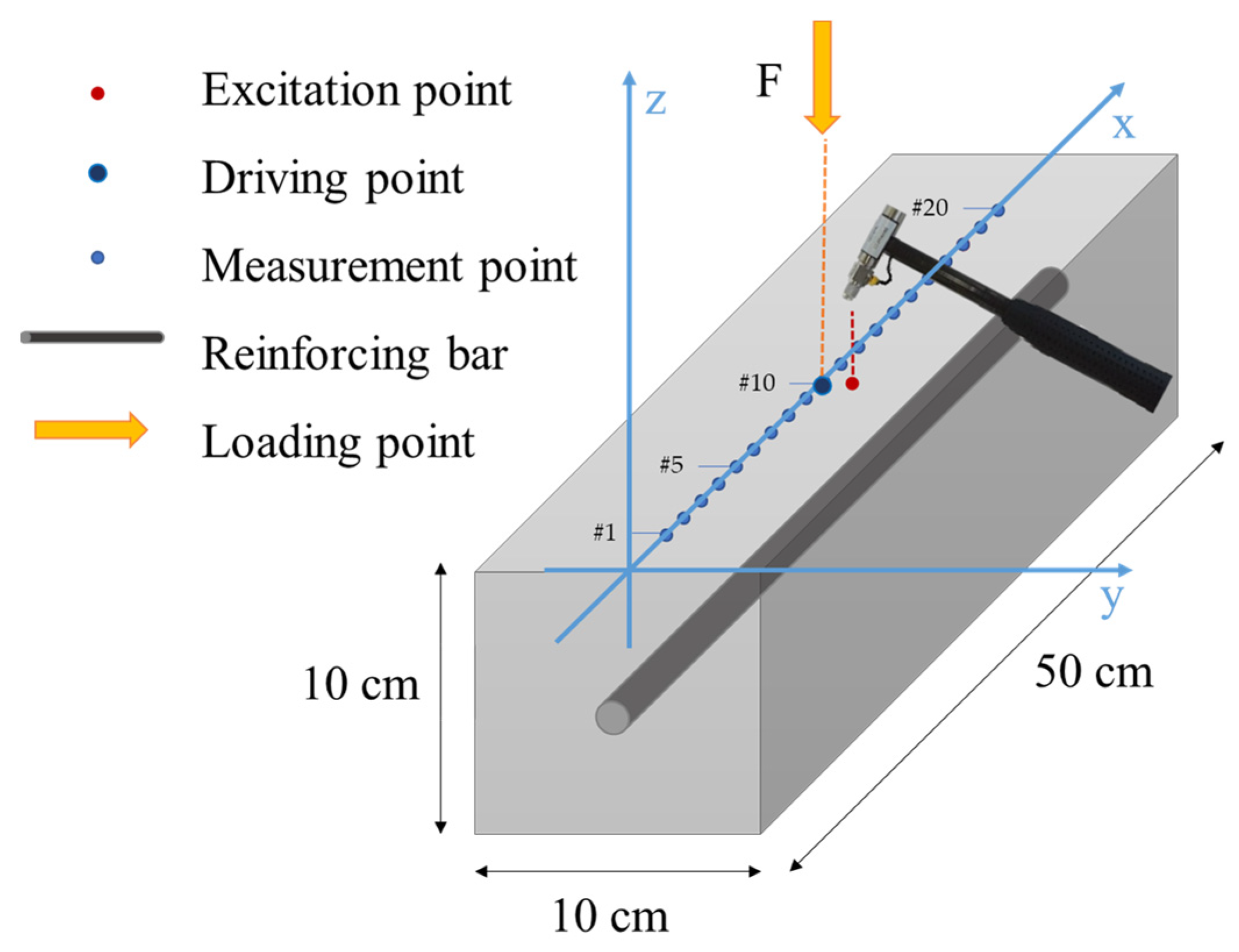
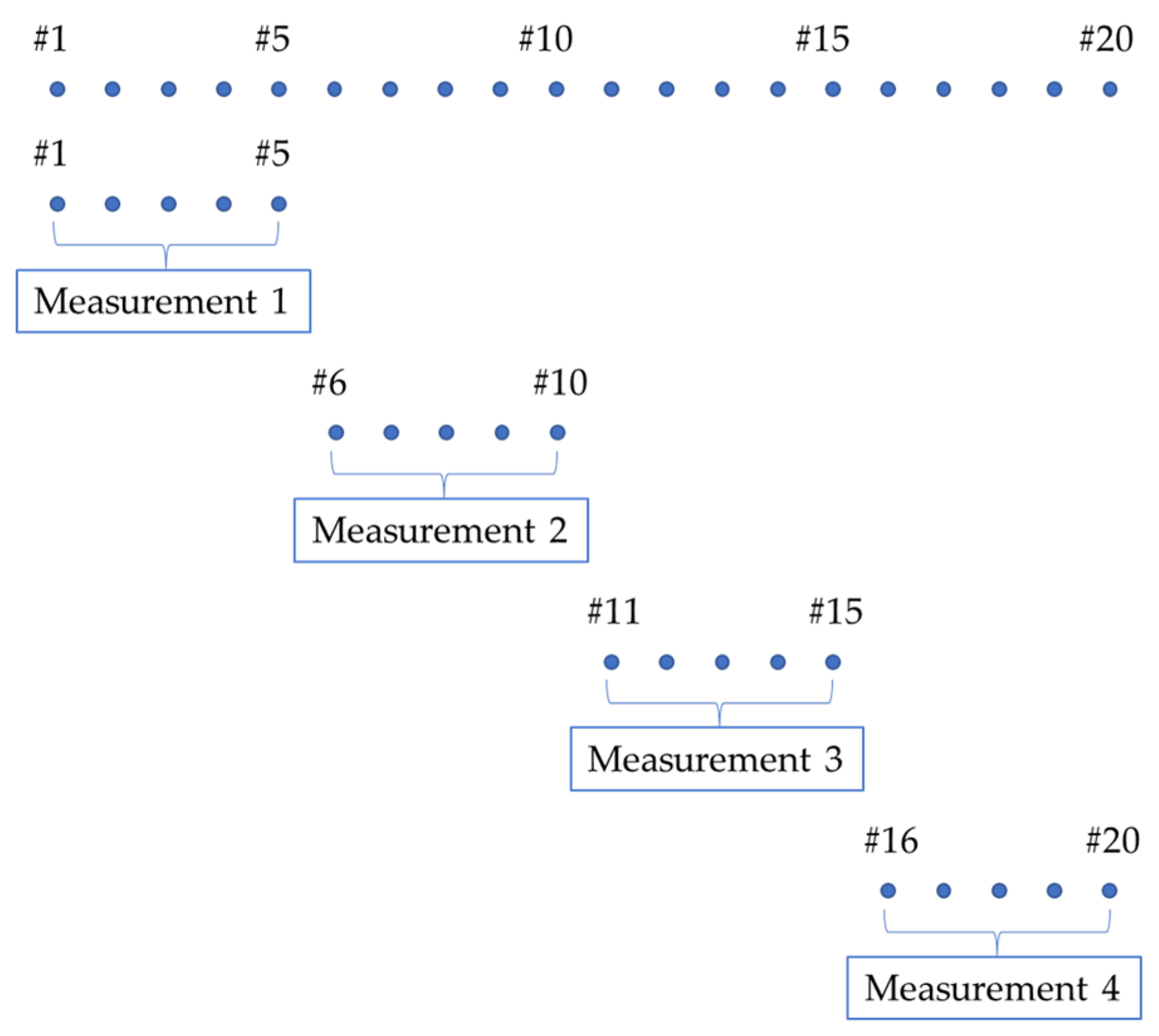
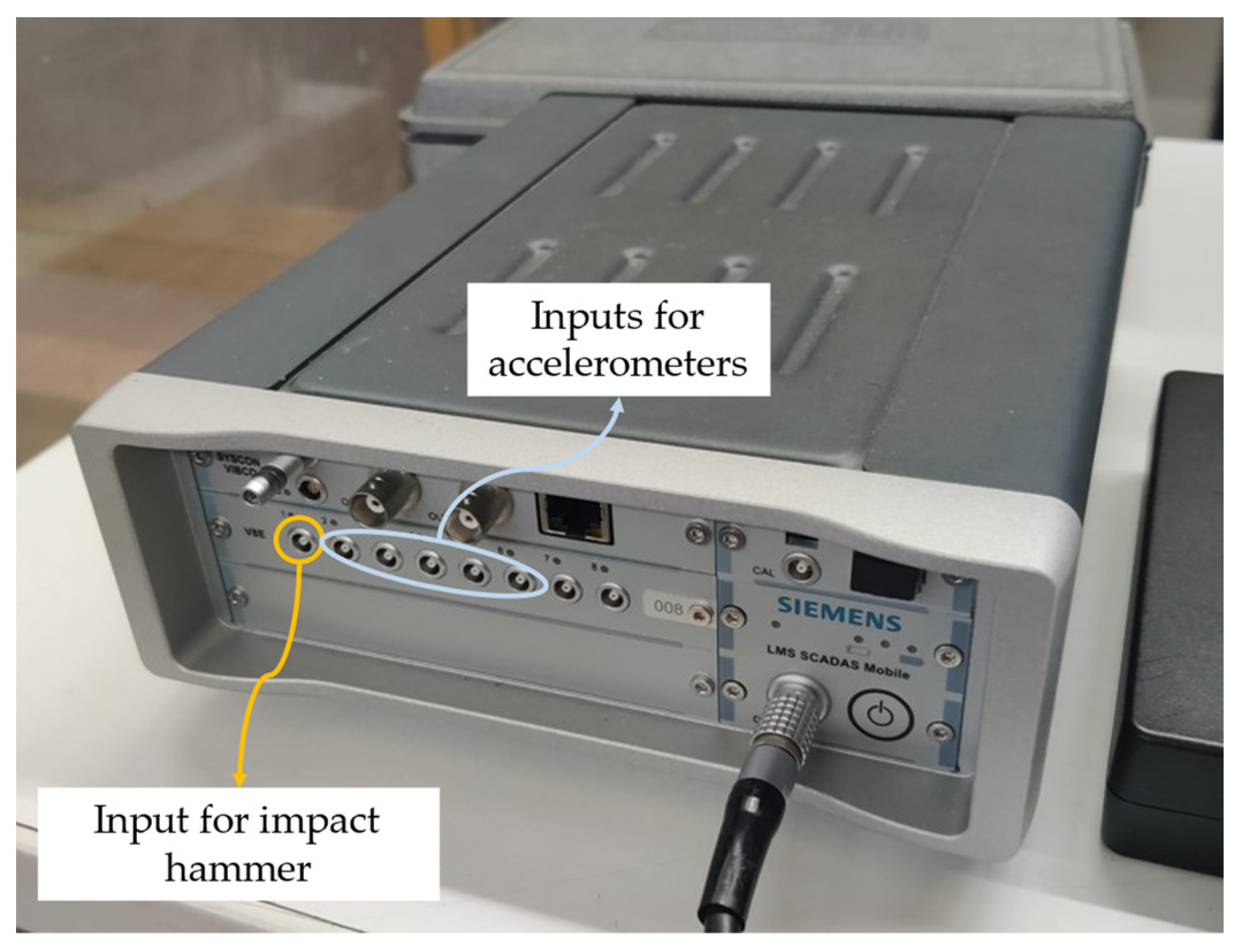


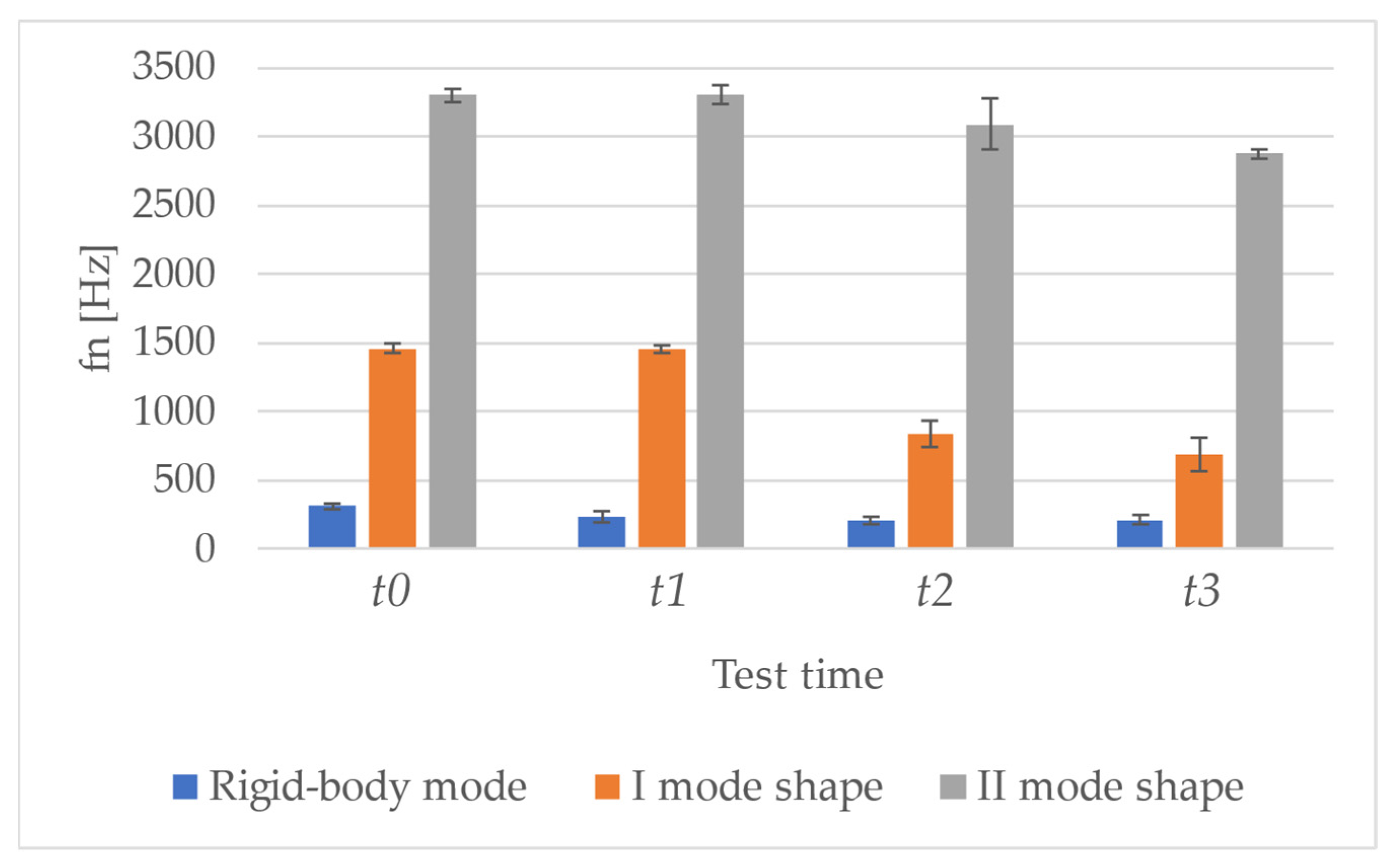
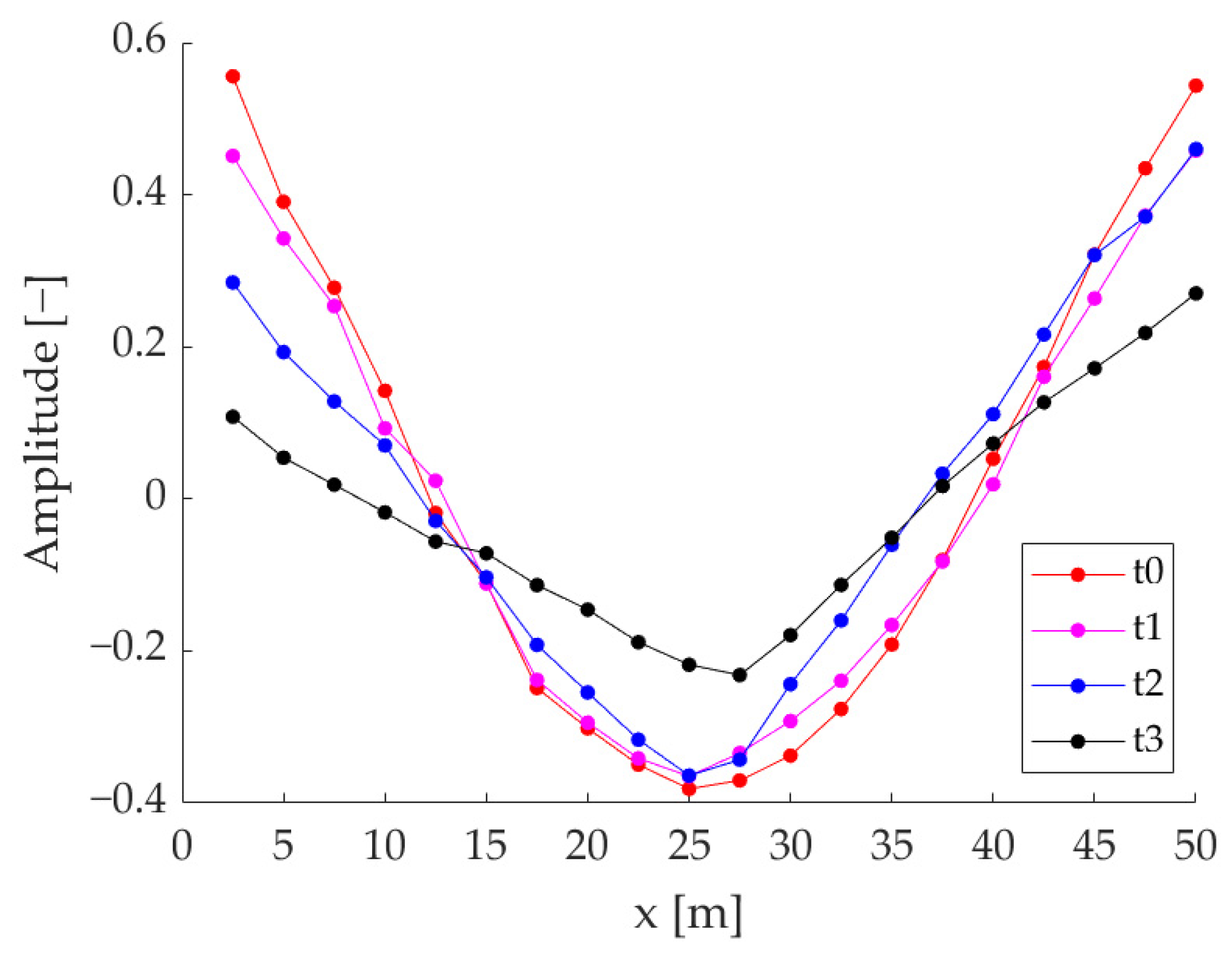
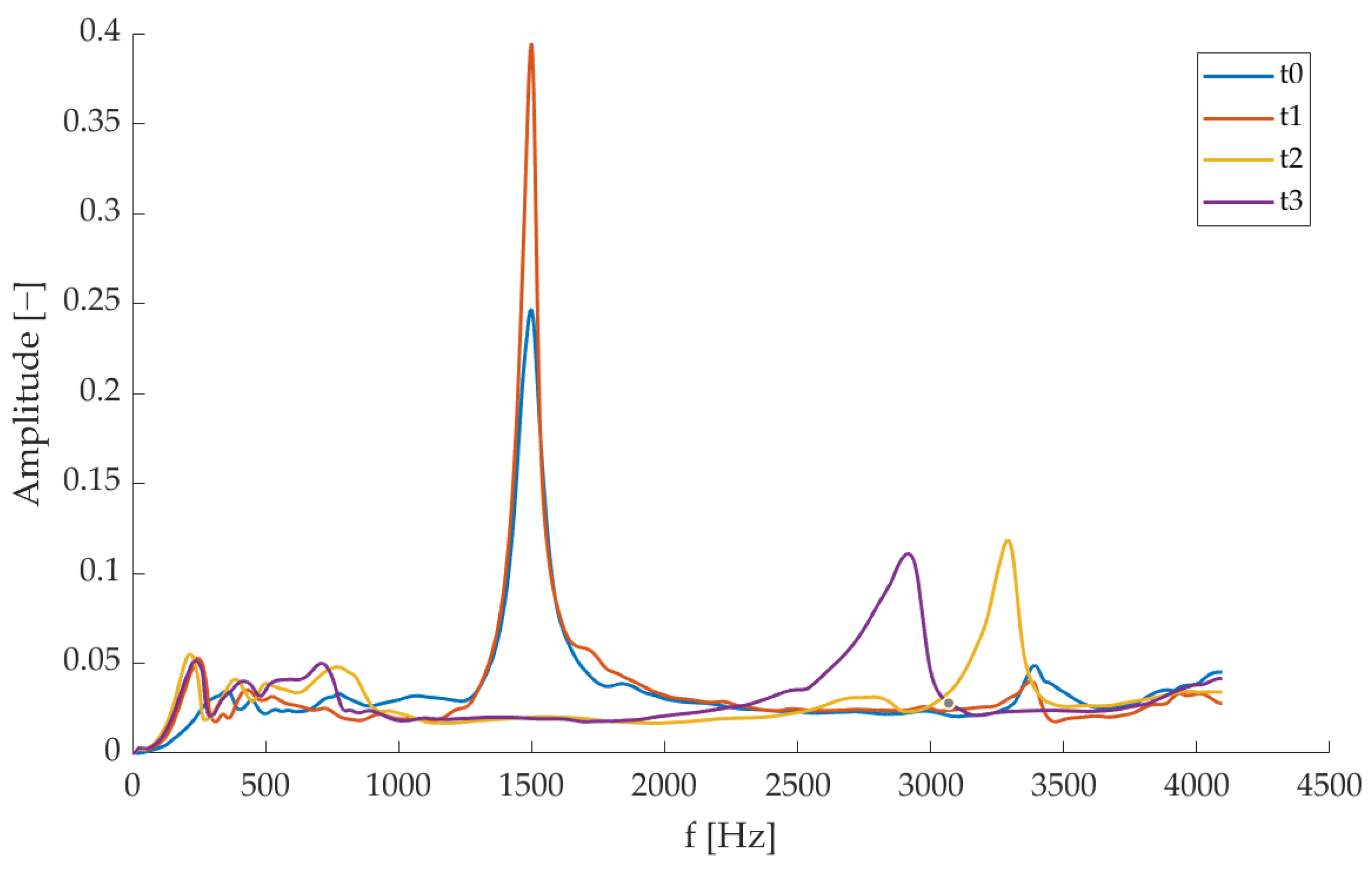

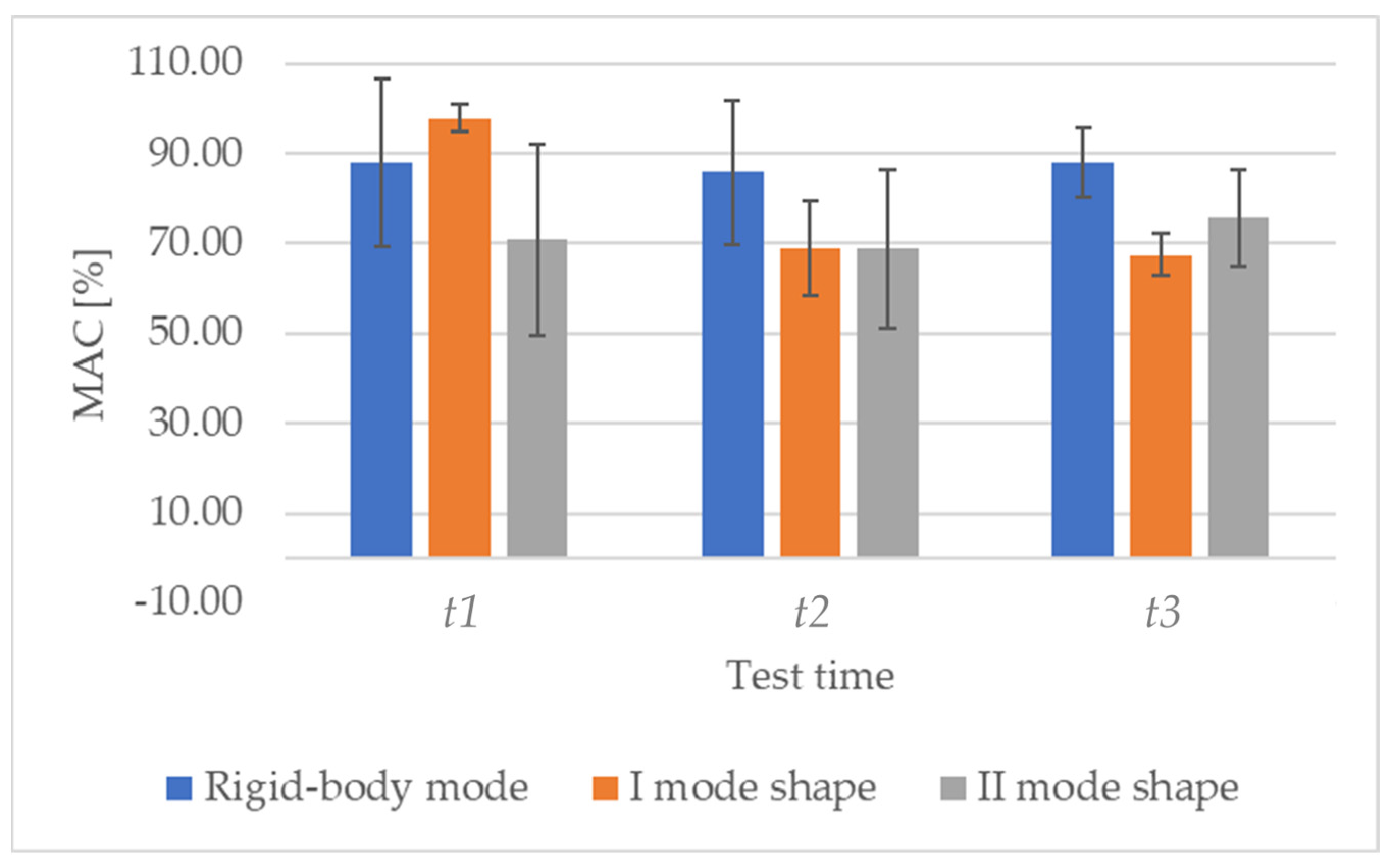
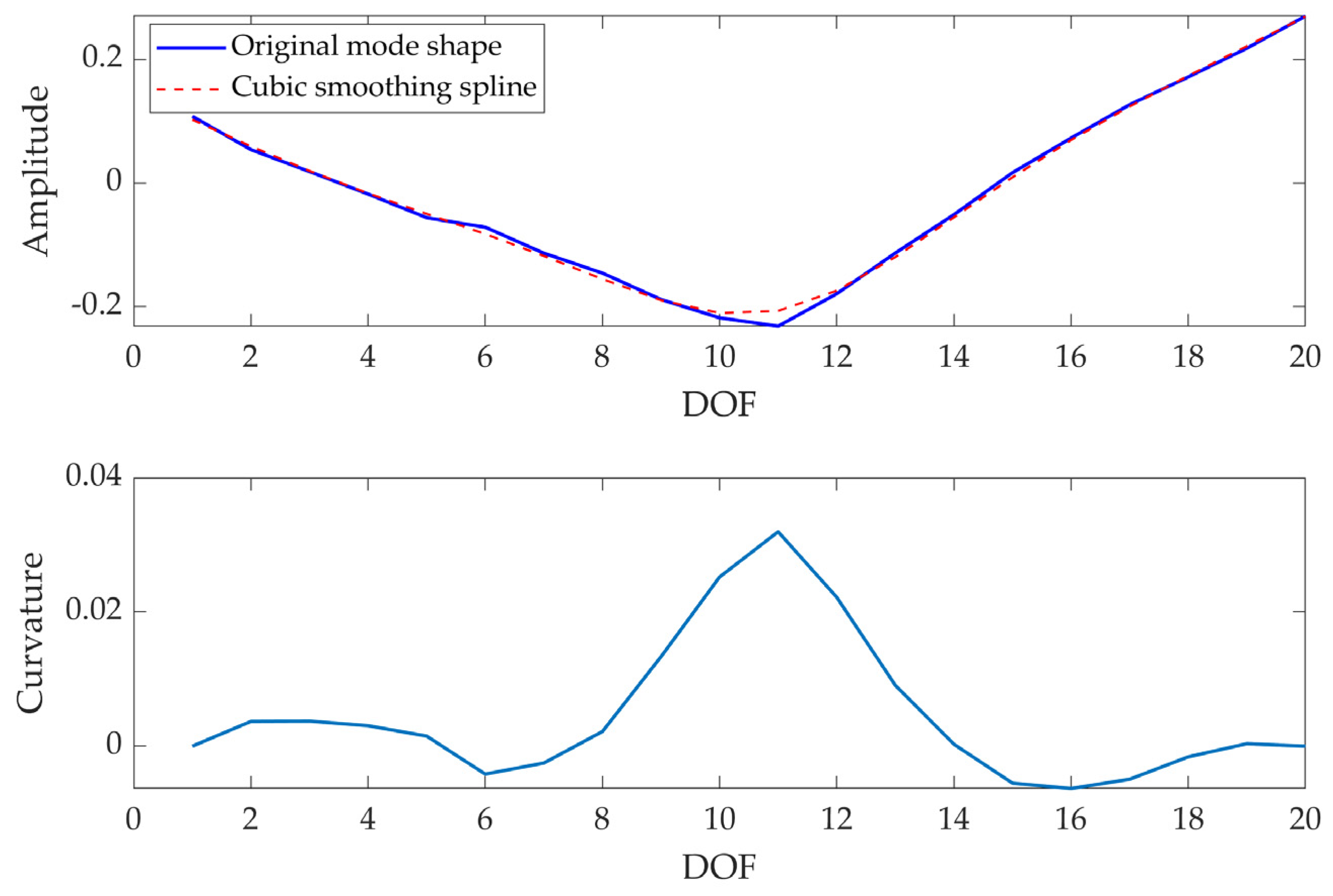
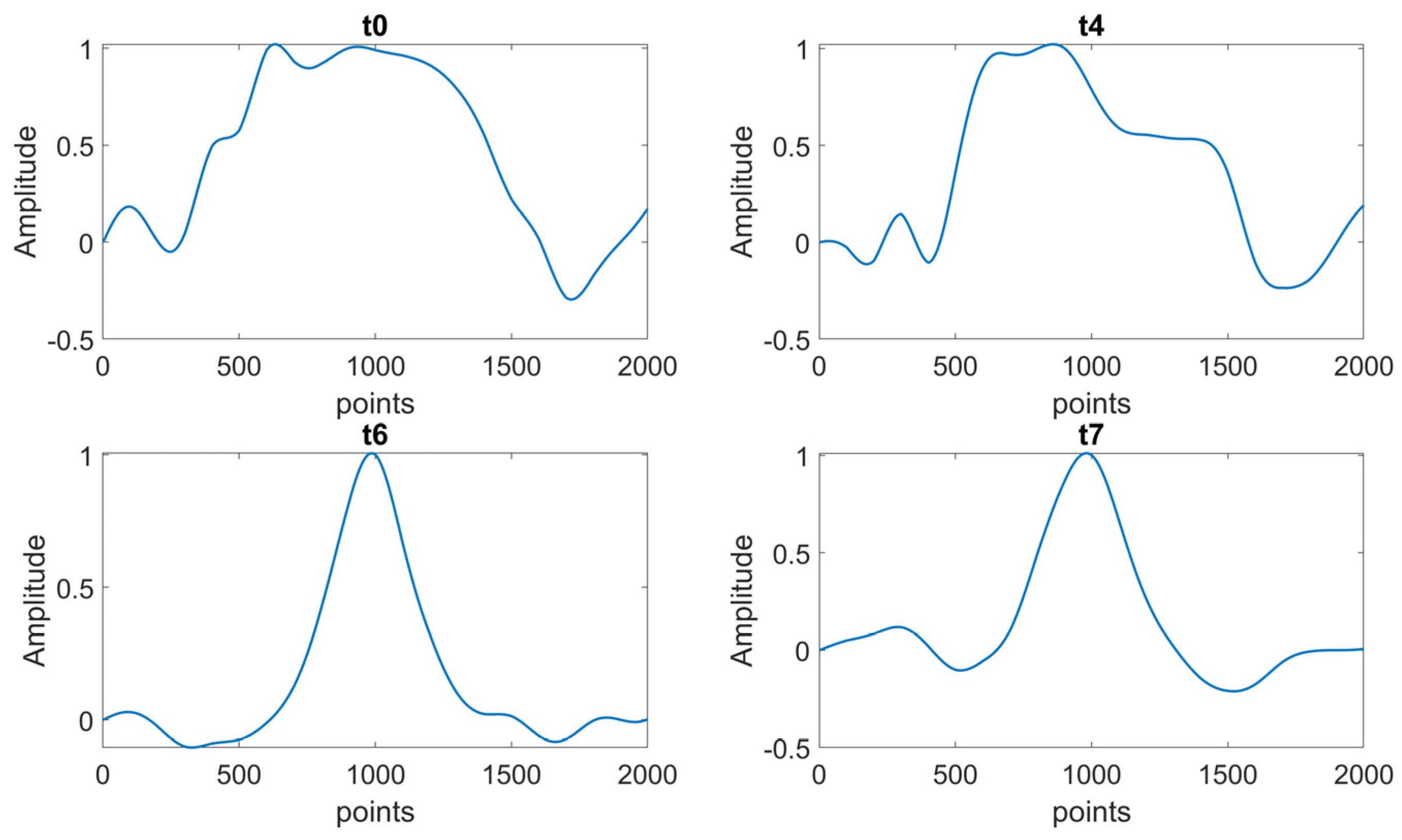
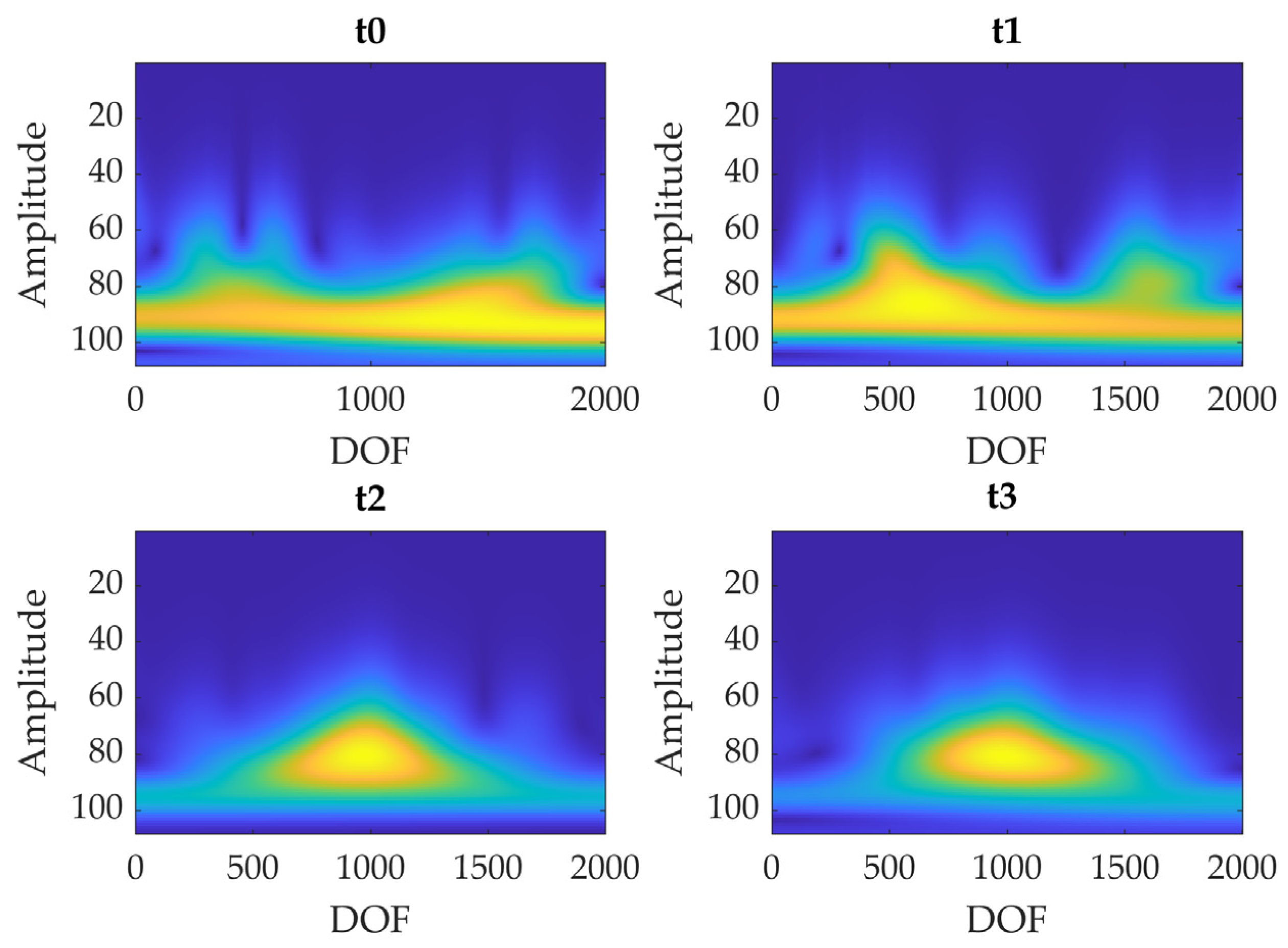
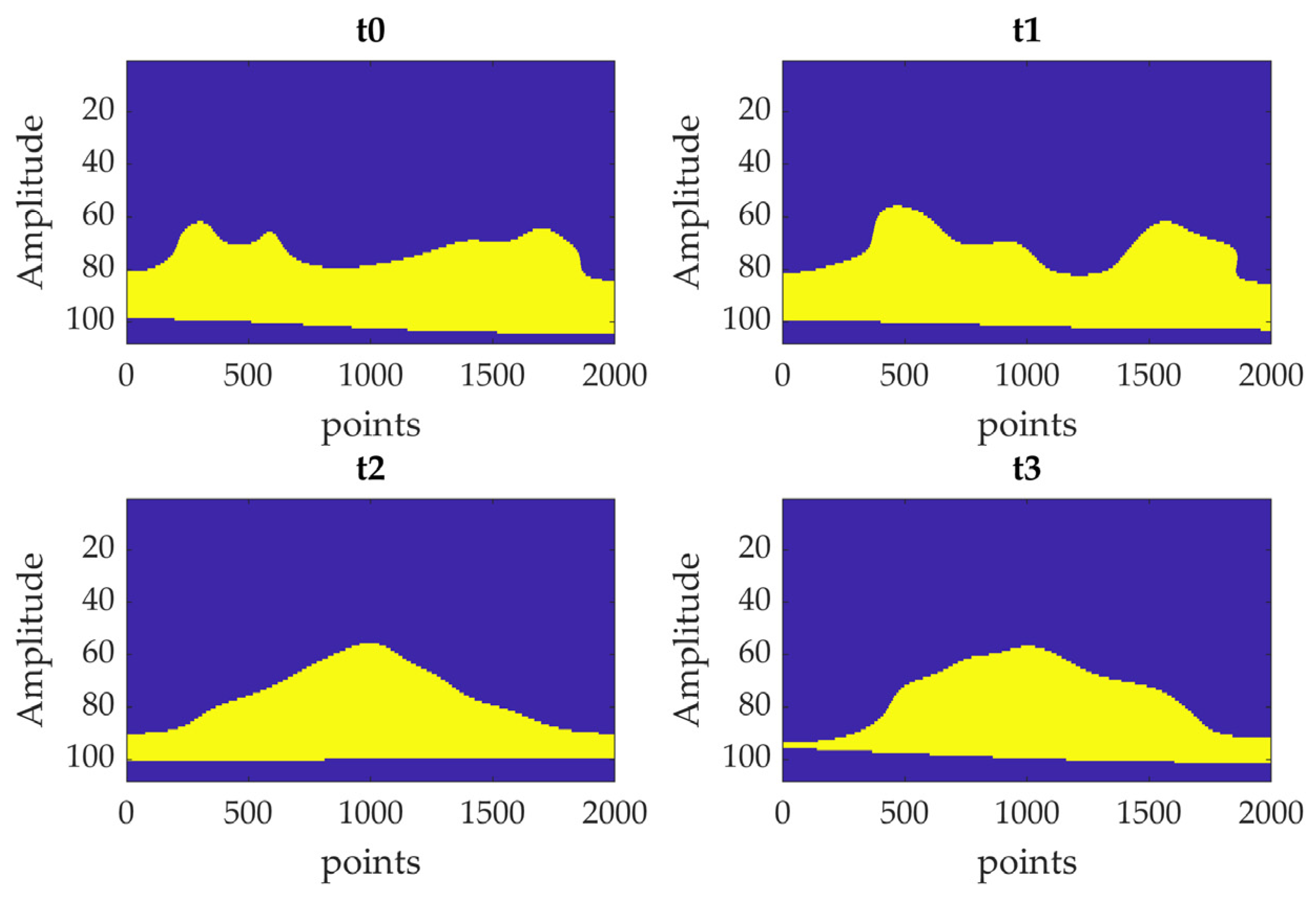

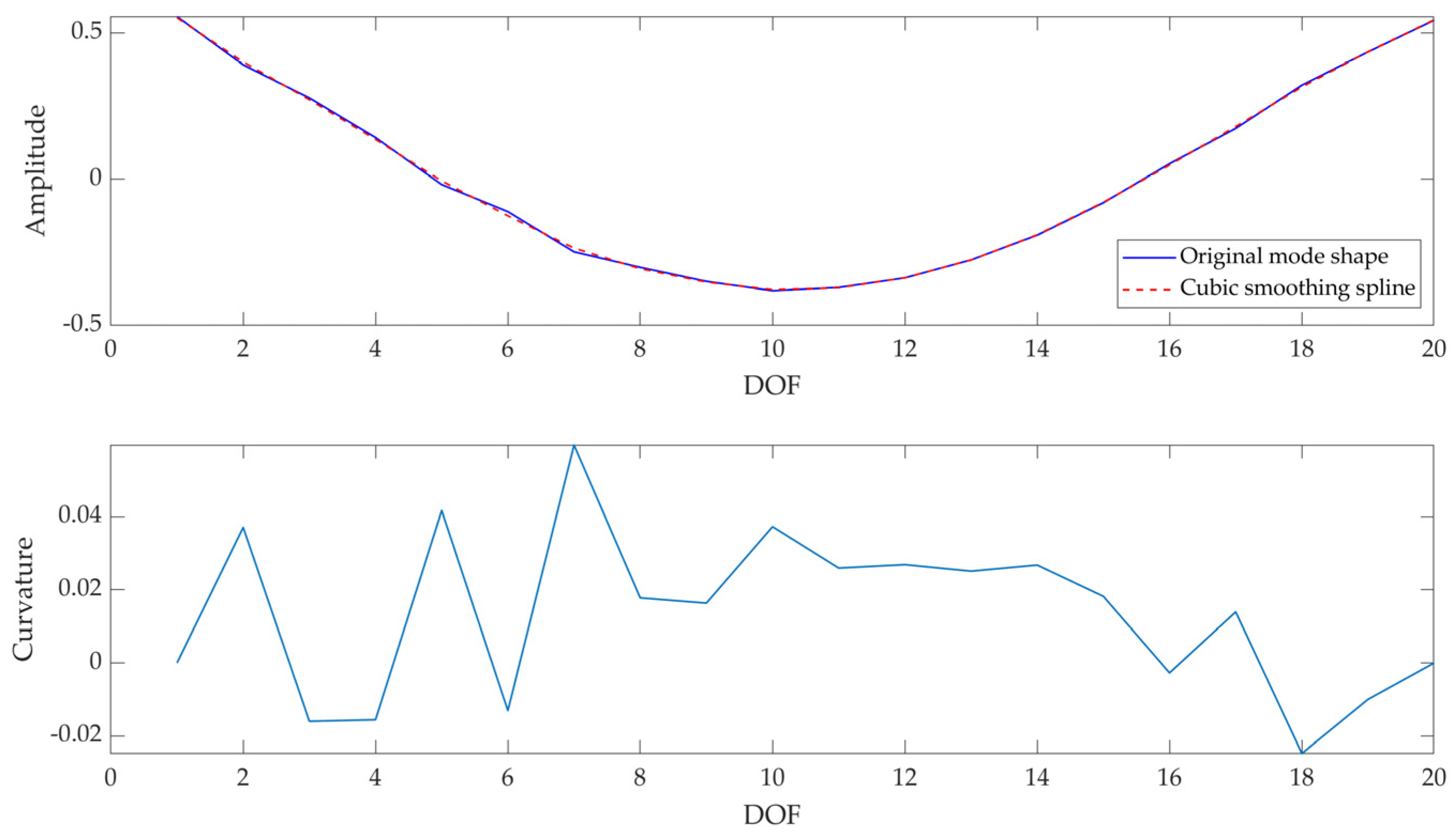
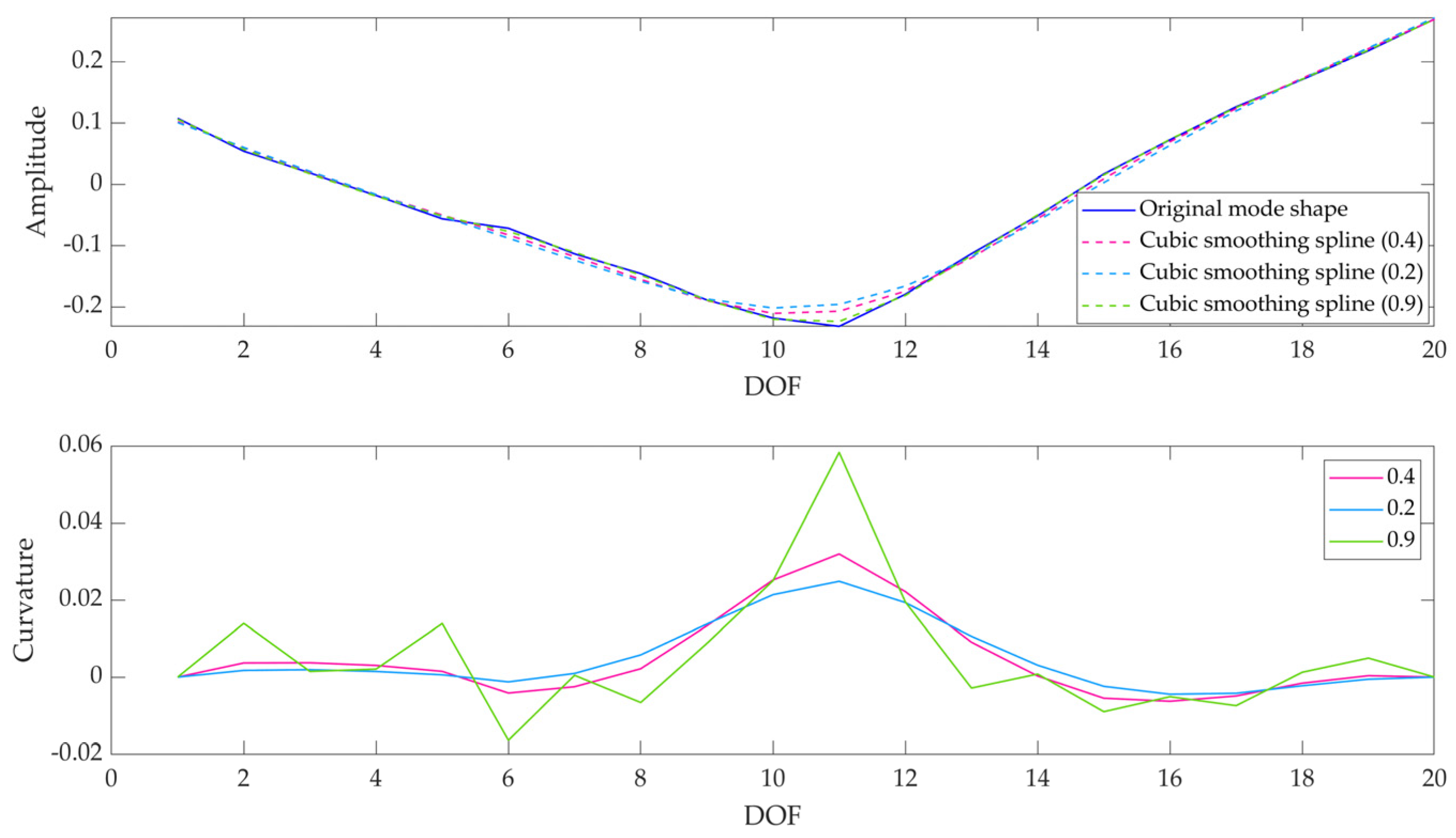
| Cement [kg/m3] | Water [kg/m3] | Air [%] | Sand [kg/m3] | Intermediate Gravel [kg/m3] | Coarse Gravel [kg/m3] | RCF [kg/m3] | BCH [kg/m3] |
|---|---|---|---|---|---|---|---|
| 470.0 | 235.0 | 2.5 | 795.0 | 321.0 | 476.0 | 0.9 | 10.0 |
| Variable | Values |
|---|---|
| Smoothing factor | 0.20 |
| 0.40 | |
| 0.90 | |
| Oversampling factor | ×2 |
| ×5 | |
| ×10 |
| Specimen | Fracture Load [kN] |
|---|---|
| A | 13.1 |
| B | 13.1 |
| C | 15.2 |
| G | 13.8 |
| H | 13.5 |
| I | 12.3 |
| Specimen | Test Time | fn (Δfn [%]) [Hz] | ||
|---|---|---|---|---|
| Mode Shape | ||||
| Rigid-Body | I | II | ||
| A | t0 | 341 (-) | 1487 (-) | 3371 (-) |
| t1 | 237 (−30.44) | 1488 (−0.07) | 3383 (−0.35) | |
| t2 | 218 (−36.12) | 796 (−46.47) | 3265 (−3.14) | |
| t3 | 210 (−38.48) | 715 (−51.92) | 2888 (−14.34) | |
| B | t0 | 329 (-) | 1446 (-) | 3273 (-) |
| t1 | 294 (−10.64) | 1442 (−0.34) | 3295 (−0.67) | |
| t2 | 249 (−24.20) | 748 (−48.30) | 3172 (−3.09) | |
| t3 | 258 (−21.64) | 481 (−66.73) | 2871 (−12.28) | |
| C | t0 | 343 (-) | 1467 (-) | 3315 (-) |
| t1 | 285 (−16.91) | 1462 (−0.33) | 3331 (−0.48) | |
| t2 | 203 (−40.82) | 794 (−45.88) | 3170 (−4.37) | |
| t3 | 259 (−24.52) | 597 (−59.33) | 2884 (−13.00) | |
| G | t0 | 289 (-) | 1519 (-) | 3338 (-) |
| t1 | 235 (−18.69) | 1487 (−2.10) | 3330 (−0.26) | |
| t2 | 199 (−31.04) | 767 (−49.50) | 2687 (−19.52) | |
| t3 | 212 (−26.48) | 870 (−42.73) | 2861 (−14.31) | |
| H | t0 | 303 (-) | 1441 (-) | 3280 (-) |
| t1 | 159 (−47.47) | 1425 (−1.10) | 3319 (−1.18) | |
| t2 | 160 (−47.19) | 951 (−33.98) | 3127 (−4.66) | |
| t3 | 181 (−40.36) | 786 (−45.41) | 2942 (−10.31) | |
| I | t0 | 300 (-) | 1403 (-) | 3224 (-) |
| t1 | 215 (−28.52) | 1412 (−0.63) | 3173 (−1.58) | |
| t2 | 206 (−31.41) | 1002 (−28.59) | 3142 (−2.54) | |
| t3 | 175 (−41.79) | 708 (−49.55) | 2829 (−12.25) | |
| Specimen | Test Time | η (Δη [%]) [%] | ||
|---|---|---|---|---|
| Mode Shape | ||||
| Rigid-Body | I | II | ||
| A | t0 | 10.76 * (-) | 1.70 (-) | 0.69 (-) |
| t1 | 2.48 (−76.99 *) | 1.15 (−32.35 *) | 0.86 (24.35) | |
| t2 | 3.99 (−62.96 *) | 3.69 (117.09) | 1.17 (69.42) | |
| t3 | 12.35 (14.80) | 3.98 (134.12) | 2.23 (223.37) | |
| B | t0 | 9.45 (-) | 1.98 (-) | 0.70 (-) |
| t1 | 10.31 (9.05) | 2.67 (35.35) | 0.95 (34.86) | |
| t2 | 17.45 (84.57) | 9.23 (367.19) | 1.42 (102.19) | |
| t3 | 20.85 (120.52) | 11.44 (479.27) | 2.25 (219.69) | |
| C | t0 | 5.56 (-) | 2.03 (-) | 0.91 (-) |
| t1 | 6.15 (10.55) | 2.27 (11.97) | 1.41 (54.93) | |
| t2 | 10.40 (87.05) | 6.30 (210.58) | 2.54 (179.82) | |
| t3 | 11.36 (104.25) | 9.14 (350.61) | 4.11 (353.01) | |
| G | t0 | 9.34 (-) | 1.59 (-) | 0.78 (-) |
| t1 | 9.34 (0.00) | 2.00 (26.14) | 0.78 (0.00) | |
| t2 | 14.75 (57.96) | 7.76 (389.43) | 2.22 (186.60) | |
| t3 | 19.12 (104.79) | 9.56 (502.87) | 3.05 (293.02) | |
| H | t0 | 1.16 * (-) | 1.46 * (-) | 1.01 (-) |
| t1 | 0.22 (−81.45 *) | 0.84 (−42.12 *) | 1.55 (52.82) | |
| t2 | 0.85 (−26.72) | 1.73 (18.82) | 2.67 (163.97) | |
| t3 | 2.38 (105.33) | 3.11 (113.36) | 2.30 (127.47) | |
| I | t0 | 9.87 (-) | 1.79 (-) | 1.17 (-) |
| t1 | 10.31 (4.51) | 2.68 (49.76) | 1.99 (70.08) | |
| t2 | 15.23 (54.29) | 3.45 (92.79) | 2.05 (75.21) | |
| t3 | 16.56 (67.78) | 7.90 (341.55) | 2.95 (152.13) | |
| Specimen | Test Time | MAC [%] | ||
|---|---|---|---|---|
| Mode Shape | ||||
| Rigid-Body | I | II | ||
| A | t0 | 93.81 | 90.97 | 29.19 |
| t1 | 93.14 | 78.19 | 59.84 | |
| t2 | 87.50 | 72.85 | 57.59 | |
| t3 | 98.63 | 98.63 | 89.64 | |
| B | t0 | 94.44 | 64.21 | 84.20 |
| t1 | 85.31 | 66.86 | 89.10 | |
| t2 | 97.47 | 99.67 | 82.71 | |
| t3 | 93.60 | 50.40 | 86.58 | |
| C | t0 | 92.14 | 60.88 | 82.65 |
| t1 | 97.13 | 99.31 | 84.85 | |
| t2 | 84.74 | 64.44 | 34.35 | |
| t3 | 94.96 | 74.40 | 83.07 | |
| G | t0 | 46.34 | 99.36 | 81.35 |
| t1 | 50.94 | 80.74 | 72.58 | |
| t2 | 72.75 | 64.52 | 75.62 | |
| t3 | 94.78 | 99.41 | 57.18 | |
| H | t0 | 97.81 | 76.38 | 75.40 |
| t1 | 95.61 | 65.20 | 66.77 | |
| t2 | 93.81 | 90.97 | 29.19 | |
| t3 | 93.14 | 78.19 | 59.84 | |
| I | t0 | 87.50 | 72.85 | 57.59 |
| t1 | 98.63 | 98.63 | 89.64 | |
| t2 | 94.44 | 64.21 | 84.20 | |
| t3 | 85.31 | 66.86 | 89.10 | |
| Specimen | Test Time | Damage Indices | ||
|---|---|---|---|---|
| DIcurv | DICWT | DIglobal | ||
| A | t1 | 4.98 | 1.01 | 4.94 |
| t2 | 8.74 | 0.83 | 10.53 | |
| t3 | 8.66 | 0.82 | 10.59 | |
| B | t1 | 3.93 | 1.17 | 3.36 |
| t2 | 7.49 | 0.89 | 8.44 | |
| t3 | 7.82 | 0.90 | 8.69 | |
| C | t1 | 2.61 | 0.96 | 2.73 |
| t2 | 8.35 | 0.81 | 10.33 | |
| t3 | 8.90 | 1.00 * | 8.92 * | |
| G | t1 | 2.13 | 0.87 | 2.44 |
| t2 | 6.03 * | 0.82 | 7.37 * | |
| t3 | 5.03 | 0.85 * | 5.93 | |
| H | t1 | 3.61 | 1.08 | 3.36 |
| t2 | 7.07 | 0.92 | 7.65 | |
| t3 | 9.13 | 0.90 | 10.16 | |
| I | t1 | 3.64 | 1.17 | 3.10 |
| t2 | 6.57 | 0.86 * | 7.65 * | |
| t3 | 7.49 | 0.89 | 8.44 | |
| Variable | Values | Test Time | Damage Indices | ||
|---|---|---|---|---|---|
| DIcurv | DICWT | DIglobal | |||
| Smoothing factor (with oversampling factor ×5) | 0.20 | t1 | 2.88 | 1.01 | 2.85 |
| t2 | 6.82 | 0.94 | 7.29 | ||
| t3 | 6.39 | 0.95 | 6.75 | ||
| 0.40 | t1 | 4.98 | 1.01 | 4.94 | |
| t2 | 8.74 | 0.83 | 10.53 | ||
| t3 | 8.66 | 0.82 | 10.59 | ||
| 0.90 | t1 | 8.09 | 0.61 | 13.22 | |
| t2 | 11.26 | 1.01 | 11.17 | ||
| t3 | 11.36 | 1.28 | 8.68 | ||
| Oversampling factor (with smoothing factor 0.4) | ×2 | t1 | 4.98 | 1.02 | 4.85 |
| t2 | 8.74 | 0.85 | 10.34 | ||
| t3 | 8.66 | 0.81 | 10.69 | ||
| ×5 | t1 | 4.98 | 1.01 | 4.94 | |
| t2 | 8.74 | 0.83 | 10.53 | ||
| t3 | 8.66 | 0.82 | 10.59 | ||
| ×10 | t1 | 4.98 | 1.01 | 4.92 | |
| t2 | 8.74 | 0.84 | 10.44 | ||
| t3 | 8.66 | 0.82 | 10.51 | ||
Disclaimer/Publisher’s Note: The statements, opinions and data contained in all publications are solely those of the individual author(s) and contributor(s) and not of MDPI and/or the editor(s). MDPI and/or the editor(s) disclaim responsibility for any injury to people or property resulting from any ideas, methods, instructions or products referred to in the content. |
© 2023 by the authors. Licensee MDPI, Basel, Switzerland. This article is an open access article distributed under the terms and conditions of the Creative Commons Attribution (CC BY) license (https://creativecommons.org/licenses/by/4.0/).
Share and Cite
Cosoli, G.; Martarelli, M.; Mobili, A.; Tittarelli, F.; Revel, G.M. Damage Identification in Cement-Based Structures: A Method Based on Modal Curvatures and Continuous Wavelet Transform. Sensors 2023, 23, 9292. https://doi.org/10.3390/s23229292
Cosoli G, Martarelli M, Mobili A, Tittarelli F, Revel GM. Damage Identification in Cement-Based Structures: A Method Based on Modal Curvatures and Continuous Wavelet Transform. Sensors. 2023; 23(22):9292. https://doi.org/10.3390/s23229292
Chicago/Turabian StyleCosoli, Gloria, Milena Martarelli, Alessandra Mobili, Francesca Tittarelli, and Gian Marco Revel. 2023. "Damage Identification in Cement-Based Structures: A Method Based on Modal Curvatures and Continuous Wavelet Transform" Sensors 23, no. 22: 9292. https://doi.org/10.3390/s23229292
APA StyleCosoli, G., Martarelli, M., Mobili, A., Tittarelli, F., & Revel, G. M. (2023). Damage Identification in Cement-Based Structures: A Method Based on Modal Curvatures and Continuous Wavelet Transform. Sensors, 23(22), 9292. https://doi.org/10.3390/s23229292











